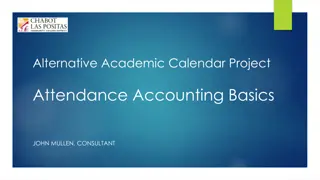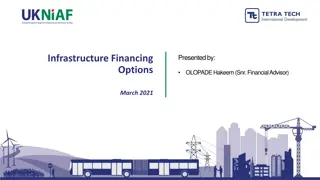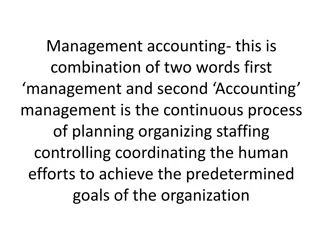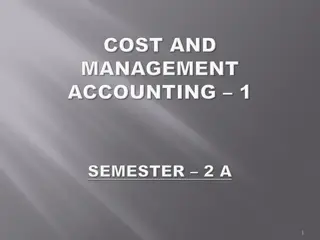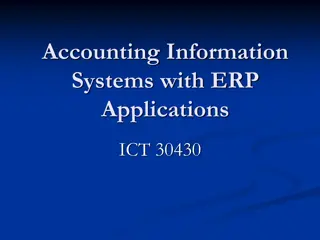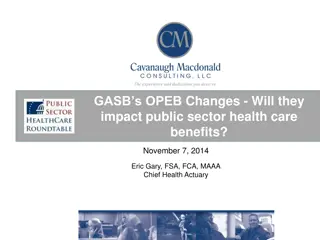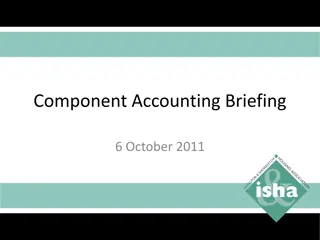Understanding OPEB Requirements and Accounting in School Finance
OPEB, or Other Postemployment Benefits, are benefits received by retired employees earned during their careers. GASB Statements 45, 74, and 75 provide guidelines for reporting and accounting for OPEB in school districts. Compliance with GASB 75 is mandatory for all districts to determine OPEB liability. Regular valuation studies are essential, and auditors may issue modified opinions if valuations are not up to date.
Download Presentation

Please find below an Image/Link to download the presentation.
The content on the website is provided AS IS for your information and personal use only. It may not be sold, licensed, or shared on other websites without obtaining consent from the author. Download presentation by click this link. If you encounter any issues during the download, it is possible that the publisher has removed the file from their server.
E N D
Presentation Transcript
Intro to OPEB Intro to OPEB Requirements and Fund 73 Requirements and Fund 73 Accounting Accounting Olivia Bernitt, School Finance Auditor DPI School Financial Services Team May 20, 2022
What is OPEB? Other Postemployment Benefits (OPEB) are post employment benefits earned by employees during their career that they receive after they are no longer active employees. Insurance benefits Health Health Reimbursement Accounts (HRA) Dental Vision Life Insurance Disability Long term care Does NOT include WRS retirement plans, pension plans, stipends or compensated absences
Why is OPEB Important? In 2004 the Governmental Accounting Standards Board issued Statement 45 (GASB 45) to provide more complete and reliable financial reporting of OPEB. Applies to all districts GASB 75 supersedes Statement 45 effective FYE 6/30/18 School districts (and other government bodies) are required to determine their OPEB liability and report this in their financial statements. Does NOT require the funding of future payments.
GASB Statements 74 and 75 GASB 74: Rules for accounting of the trust fund. Compliance is Only required if the district has established a trust fund Therefore, NOT required of all districts GASB 74 has replaced GASB 43 FYE 6/30/17 GASB 75: Rules governing the determination of OPEB liability, establishing a Plan, identifying the ADC, etc. Compliance is required of all districts
GASB 75 For OPEB, all districts must have new valuation studies completed every 2 years Significant changes to employee benefits should result in a new actuarial study even if before the next scheduled study. Plan members are those active employees eligible to receive those future benefits, terminated employees who have accumulated the benefits but are not yet receiving them, and retired employees (or their beneficiaries) currently receiving benefits. Reevaluation of the benefits of having Fund 73 Trust should be made.
GASB 75 What does it mean for the district? - All Districts Need to be sure they have a current valuation that can be used in the filing of the audited financial statements May want to start checking NOW to see if your districts are up to date on their valuations What does it mean for the auditor? Without a current valuation, the auditor may have to issue a modified opinion or hold off on issuing the report until study completed Key items from the study are included in the district s financial statements
What method should you use to determine the OPEB liability? Actuarial Study Required for OPEB plans Required for pension plans (non-OPEB)
Actuarial Studies Actuarial firms listed on the DPI website on the bottom of the Benefit Trust Fund page or directly at http://dpi.wi.gov/sfs/finances/fund-info/employee-benefit- trust-fund These are not DPI recommendations Ask for AND check references! Talk to other districts or your auditors DON T wait until the last minute to hire an actuary Typically takes 10+ weeks to complete AFTER they have all the required information
Key Terms in the Study Total OPEB Liability (TOL) The value of benefits for all periods prior to the current fiscal year. This value is accrued, and the benefits are earned, during the employment period. Service Cost (SC) The value of benefits earned in the current year. Net OPEB Liability The difference between Total OPEB liability and the value of assets dedicated to the liability (PFNP). Plan Fiduciary Net Position (PFNP) Value of trust assets as of the valuation date
Key Terms in the Study Actuarially Determined Contribution The employer s contribution to offset the liability Equals SC + one year amortized value of the Net OPEB Liability. The annual amount a district is required to record as their liability on the financials. Not actually the amount a district is required to contribute in a given year, but the amount needed in that year to fully fund the liability over the period of amortization.
Implicit Rate Subsidy (IRS) What is it? When retirees and active employees are on the same health insurance plan, generally the premiums are higher than if the active employees had their own plan. The difference between what the active employees pay with the retirees on their plan and what they would pay on a plan with just active employees is the Implicit Rate Subsidy.
Paying For Those Future Obligations Option 1 Districts that do NOT set aside funds, fund their obligation on a Pay As You Go basis. Example, the retiree insurance premium is paid out of fund 10, function 292000, object 290 during the period in which they are retired and receive that benefit
Paying For Those Future Obligations Option 2 Districts may choose to set aside funds for the future payments towards the OPEB liability while employees are active. This is governed by GASB 74 REQUIRES establishing a segregated trust fund WUFAR Fund 73 Trust appoints a trustee These assets no longer belong to the district
What is Fund 73 A trust fund established specifically to account for post employment benefits Segregated fund to account for resources held in trust for post employment benefits Established if the district creates a formal and legal trust, in accordance with State statutes Federal laws IRS guidelines
Considerations of whether to establish a trust? Pay as you go No assurance funds will be available for benefits Fund balance set aside for benefits does not reduce financial statement liability Effect on bond rating Retiree benefits paid from operating funds Trust Assurance funds will be available for benefits Contribution reduces financial statement liability Effect on bond rating Retiree benefits paid from trust
Considerations of whether to establish a trust? Trust GASB 74 and 75 reporting in financial statements Segregation of assets Assets invested under WI Stat. 881.01 Reporting at annual meeting Pay as you go GASB 75 reporting in financial statements No segregation of assets Assets invested under WI Stat. 66.0603
Considerations of whether to establish a trust? Pay as you go Aid eligibility General aid Benefits paid during current year Categorical aid not eligible Federal and State grants not eligible Trust Aid eligibility General aid Contribution amount not exceeding unfunded liability plus normal cost Categorical aid Contribution amount not exceeding ADC Federal and State grants Contribution amount not exceeding ADC
What are DPI requirements when setting up a trust? E-Mail to DPI Actuarial Study Employee benefit trust agreement Legal opinion Board approval https://dpi.wi.gov/sfs/finances/fund-info/employee- benefit-trust-fund
What investment opportunities are available to the trust? 2005 Wisconsin ACT 99 Funds held in trust to provide for post- employment health care benefits may be invested in the same manner as is authorized for investments under 881.01, Uniform prudent investor act . Enacted into law January 4, 2006
What ALL can be in Fund 73? OPEB - Valued in actuarial study Wide variety of benefits included Supplemental Stipend Type Pension - Valued in study Traditional Pension - Separate valuation (only a few districts have this, similar to WRS) Fully funded HRAs Active employee current use Active employee for use during retirement TSAs Prefunded Termination Benefits
Accounting For Fund 73 - OPEB District contributions to Trust Retiree contribution to Trust (if applicable) Payments to vendors for retirement benefits Implicit Rate Subsidy Payback ALL SEPARATE CASH TRANSACTIONS!! Cash MUST move in full No netting No book entries Must move within 30 days of year end (July 30th)
Accounting Related to Fund 73 District contributions to Trust Expensed to district Funds (10, 27, 50, 80 ) Object Code 218 (Contribution to Employee Benefit Trust) Allocated across funds and functions of active employee plan members By FTE or salaries Amount paid in excess of ADC must be coded to function 292000 Fund 73 OPEB Revenue Code 951 District Funds Object 218 = Fund 73 Source 951
Accounting For Fund 73 - OPEB Retiree contributions to Trust Deposited to Fund 73 trust Revenue Source 952 If the district can t directly deposit into the trust, when received, instead of a Fund 10 revenue, district should set up a Due to Fund 73 account (Function 812000). This is not district revenue and should never be coded to a revenue account.
Accounting For Fund 73 - OPEB Payment of Retiree Benefits from the Trust Paid directly to Vendor 73E-420000-991 District pays with Trust Reimbursing District (Fund 10) pays vendor and charges to 714000 - Due From Fund 73 NEVER AN EXPENDITURE TO DISTRICT Trust Records a Due to Fund 10 Debit 73E-420000-991 Credit 73B-812000 Actual Cash, IN FULL, must be transited to district.
Accounting For Fund 73 - OPEB Implicit Rate Subsidy Payback Implicit Rate Subsidy Payback is an expenditure of the trust (retiree benefit) if retirees are on the district s health insurance plan, UNLESS Self-funded and trust pays actual medical costs Plan premiums rated separately for retirees Immaterial as determined by actuary
Accounting For Fund 73 - OPEB Implicit Rate Subsidy Payback Implicit rate subsidy payback is paid to the district from the trust and reduces the healthcare costs of active employee plan members with health insurance. MUST BE ALLOCATED to employee fund, function and project Even if no contribution that year, implicit rate subsidy payback applies. Implicit rate subsidy payback calculation includes any amounts paid directly from retiree to insurance company. Do not use amount from study, must be applied to actual health and long-term care insurance costs of retirees on the plan.
Accounting For Fund 73 - OPEB Implicit Rate Subsidy Payback Expenditure from the Trust to the District Debit 73E-420000-994 Credit 73B-711000 Receipt of Implicit Rate Subsidy Payback from the Trust Debit xxB-711000 Credit xxE-xxxxxx-241 Fund 73 trust must pay the district IN CASH and IN FULL for the Implicit Rate Subsidy Payback.
Accounting For Fund 73 - OPEB Sample of Activity Spreadsheet on the Benefit Trust Fund page Multiple tabs to guide you through the transactions Fund 73 - Account Descriptions Employee Benefit Fund Requirements Compliance guidance Start here if you are new https://dpi.wi.gov/sfs/finances/fund-info/employee- benefit-trust-fund
How DPI requirements are audited Annual Report edits Amount of contribution from the district equals the revenue into the trust. Check: Total of object 218 s (all funds) equal to Contribution in fund 73, source 951+ 953 Did they meet one of the 3 criteria for state categorical aid (unless 1st year of the trust)? 1) Contribution = ADC 2) Contribution (73R 951) is 5% greater than the expenditures out of the trust for OPEB (73E, Objects 991 and 994) 3) Same as number 2 but looking at 3 years If it did not meet one of the criteria, not eligible for special education categorical aid and it will need to be moved to project 019.
How DPI requirements are audited Manual Report edits If a district has a trust, are they using it? Check: If beginning Fund Balance, are there expenditures? Is the implicit rate subsidy payback being done? Check #1 - Auditor should check Check #2 - DPI will see if a district is using Object 994 for the Implicit Rate Subsidy Payback and if not will ask a question during the manual review.
How DPI requirements are audited Manual edits continued: Did the contribution exceed the ADC? Check: Is there at least the amount in excess of the ADC in Function 292000, Object 218? Excess not eligible for categorical aid If a new study is due, does DPI have a copy? Audit program should be done as part of the audit Contribution required to be physically made within thirty days of June 30th (July 30th) Was activity budgeted for?
HRA differences HRA/HSA document lists all scenarios for HRA payments to Trust under Payroll And Benefits Prefunded for active employee retirement Current active employee use Current retiree use https://dpi.wi.gov/sfs/finances/wufar/accounting-issues-examples HRA is valued in actuarial study - prefunded for retirement Accounting follows traditional OPEB At retirement, district will put $1,000 into an HRA for each year worked but does not put the full $1,000 into the trust every year. Unfunded liability exists. Also, could fund but not allocated under employee s name in HRA account.
HRA differences HRA is fully funded when earned - prefunded each year, in full, for retirement MUST GO INTO IRREVOCABLE ACCOUNT District puts away $1,000 in each year an employee works for use at retirement. The full $1,000 is funded every year and is allocated and held in the HRA account in the employee s name. Obligation is fully funded and will not be valued in the actuarial study. Allocated to employee fund, function and project Earnings belong to benefit plan
Changing Benefits - Considerations Elimination of other post employment benefits for some or all current employees Districts CANNOT eliminate post employments benefits to retirees. That obligation remains. What are the steps to be followed if OPEB trust assets exist and no future liability exists? Consult the trust document for any language addressing dissolution of the trust Consult with legal counsel and/or your actuary Notify the School Financial Services Team
Questions? Questions? Olivia Bernitt SFS Auditor olivia.bernitt@dpi.wi.gov 608-261-2137 General Contact Information https://dpi.wi.gov/sfs DPIfin@dpi.wi.gov 608-267-9114






